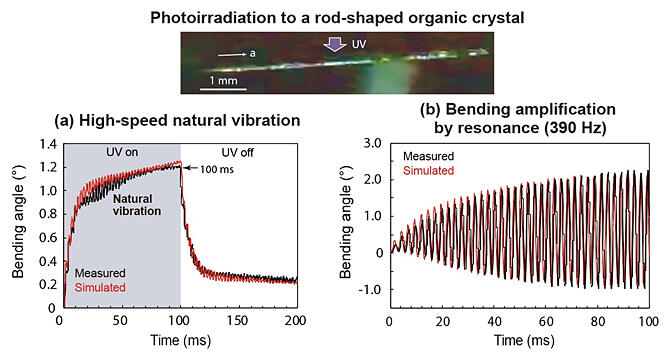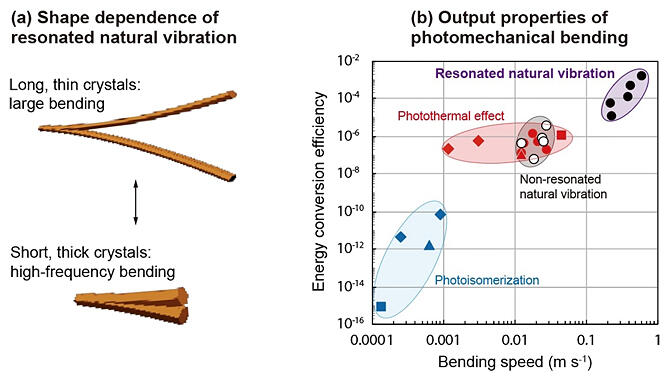In the development of mechanical crystals that convert external stimuli, such as light and heat into motion, phenomena, such as photoisomerization, phase transitions, and photothermal effects have been used as driving sources. However, it has been difficult to create high‐speed and large motions. A research group led by Visiting Researcher Hideko Koshima of the Research Organization for Nano & Life Innovation, Professor Toru Asahi of the Faculty of Science and Engineering, Waseda University and Research Fellow (DC1) Yuki Hagiwara of Japan Society for the Promotion of Science (JSPS), along with Professor Junko Morikawa of the Tokyo Institute of Technology, have discovered that natural vibration occurs in crystals upon light irradiation, causing high‐speed bending. They also discovered for the first time in the world that the bending caused by resonance upon light irradiation at natural frequency is considerably large. This discovery could lead to the development of versatile high‐speed crystal actuators and soft robots and was published in Nature Communications.
Mechanical crystals that convert external stimuli, such as light and heat into motion have the potential to be used in lightweight and soft actuators and soft robots. Over the past 15 years, Koshima and her team have developed many mechanical crystals, focusing on photoisomerization and phase transition as a principle to induce crystal motion. However, the number of crystals that undergo photoisomerization or phase transitions is limited. Photoisomerization‐induced bending motion is slow, lasting only a few seconds, and thick crystals are resistant to bending. In 2020, they discovered that at a high frequency of 25 Hz, the photothermal effect caused a thick crystal to bend. They then used another crystal to simulate the bending mechanism initiated by the photothermal effect. However, the bending angle owing to the photothermal effect was generally between 0.2‐0.5° and was insufficient to induce large motions.

Provided by Waseda University
Natural vibration is a phenomenon during which a material continues to vibrate at a certain frequency (natural frequency) upon application of an external force. Resonance occurs when an external force has the same frequency as the natural vibration, resulting in an amplified vibrational motion. Musical instruments, such as guitars and saxophones create sound (vibration) through the movement of strings or reeds. This sound is amplified through resonance in a box or tube. Although natural vibrations are widely involved in our daily life, their use in moving material actuation has not been extensively researched.
Initially, the research group focused on organic crystals with a large thermal expansion to achieve large bending through the photothermal effect. However, during this process, they discovered that a minute natural bending of 0.1° occurs at a high frequency of 390 Hz, accompanied by a large bending of 1.2° in 100 millimeters per second (mm/s) owing to the photothermal effect.
When irradiated with pulsed light of 390 Hz, which is the same frequency as the natural vibration, the natural vibration was amplified to 3.4° by resonance. In other words, they discovered that high‐speed and large bending of crystals can be achieved by resonated natural vibration. To explain this mechanism, they simulated the bending of a crystal. their assumption was that the crystal gets deformed by the temperature gradient formed by heat conduction due to the photothermal effect inside the crystal and that the thermal stress generated at the same time causes the crystal to vibrate.

Provided by Waseda University
As a result, the bending without resonance and the bending amplified by resonance were successfully reproduced. Furthermore, by changing the crystal shape, different resonated natural frequencies in the range of 200‐700 Hz were observed, and it was found that longer and thinner crystals can create large bending, whereas shorter and thicker crystals can create fast bending. By comparing the bending speed and energy conversion efficiency of light into bending motion for these resonated natural vibrations with the bending due to photoisomerization, the photothermal effect and non‐resonated natural vibration, it was found that the fastest bending speed of 0.2‐0.7 meters per second (m/s) and the highest energy conversion efficiency (≤ 0.1%) could be obtained.
In this study, the researchers discovered for the first time that crystals can be significantly bent at high speeds using resonated natural vibrations and were also successful in reproducing this bending by simulation. By focusing on the resonance of natural vibrations, any crystal can be significantly bent at high speed. Because the bending can be simulated, it is also possible to design the desired motion by changing the parameters, such as the type and size of the crystal and light irradiation conditions.
Koshima stated, "Many studies on light‐driven crystals have been reported over the past 15 years. With the discovery we have found that any crystal can be actuated significantly at high‐speed using resonated natural vibrations. As a result of this research, we believe that mechanical crystals can be used in practical applications, such as actuators and soft robots. In the future, we would like to promote the application of mechanical crystals in actuators and soft robots and expand a wide range of research from basic research to practical applications."
This article has been translated by JST with permission from The Science News Ltd. (https://sci-news.co.jp/). Unauthorized reproduction of the article and photographs is prohibited.




